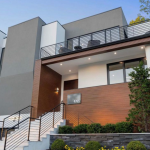
LEED Certification Made Easy: How Aluminum Cladding Helps You Go Green

Why Architects Are Choosing Aluminum Cladding for Biophilic Design

Prefabricated buildings are rapidly becoming a popular choice in modern construction due to their efficiency, cost-effectiveness, and flexibility. As this trend grows, the materials used in these structures must meet high standards of durability, aesthetics, and sustainability.
Aluminum cladding is proving to be a game-changer in this context, offering numerous benefits that enhance the performance and longevity of prefabricated buildings. Here’s why aluminum cladding is a must-consider option for your next project.
1. Lightweight and Durable Construction
Aluminum cladding is known for its lightweight nature, which significantly reduces the overall weight of prefabricated buildings. This reduction in weight leads to lower transportation costs and easier installation, making the construction process faster and more efficient.
Despite being lightweight, aluminum is incredibly durable, offering long-term protection against harsh weather conditions, corrosion, and other environmental factors that can degrade building materials over time. This durability ensures that prefabricated buildings remain robust and structurally sound for years to come.
2. Energy Efficiency
One of the standout features of aluminum cladding is its contribution to energy efficiency. Aluminum cladding can incorporate insulation materials that help regulate interior temperatures, reducing the need for extensive heating or cooling.
This not only lowers energy consumption but also contributes to a smaller carbon footprint, making prefabricated buildings more sustainable. Additionally, aluminum’s reflective properties help to deflect sunlight, keeping interiors cooler in hot climates, further enhancing energy efficiency.
3. Versatile Design Options
Aluminum cladding offers a wide range of design possibilities, allowing architects and designers to create visually appealing and unique facades for prefabricated buildings. The material can be shaped, colored, and finished in numerous ways, providing endless options for customization. Whether you’re aiming for a sleek, modern look or a more traditional aesthetic, aluminum cladding can be tailored to meet the specific design needs of your project.
4. Low Maintenance and Long-Term Value
Aluminum cladding is highly resistant to rust, corrosion, and fading, which means it requires minimal maintenance over its lifespan. This low-maintenance feature is particularly beneficial for prefabricated buildings, where cost efficiency is often a priority.
The reduced need for repairs or repainting translates into long-term savings, making aluminum cladding a cost-effective investment. Furthermore, the material’s durability ensures that the building remains protected and retains its aesthetic appeal, contributing to its long-term value.
5. Fire Resistance and Safety
Safety is a crucial consideration in building construction, and aluminum cladding excels in this area as well. The material is non-combustible and has a high melting point, making it highly resistant to fire.
In the event of a fire, aluminum cladding helps prevent the spread of flames, providing an additional layer of protection for the building’s occupants. This fire resistance is particularly important for prefabricated buildings, which may be used in various environments and for different purposes.
6. Sustainability
Sustainability is becoming increasingly important in construction, and aluminum cladding is an excellent choice for eco-friendly building practices. Aluminum is fully recyclable, and using recycled aluminum significantly reduces the environmental impact of construction projects.
The material’s long lifespan also contributes to sustainability by minimizing the need for replacements and reducing waste. For those looking to create green buildings, aluminum cladding offers a sustainable solution that aligns with modern environmental standards.
Conclusion
Aluminum cladding is a versatile, durable, and sustainable material that offers numerous benefits for prefabricated buildings. Its lightweight nature, energy efficiency, and design flexibility make it an ideal choice for modern construction projects.
Additionally, the material’s low maintenance requirements, fire resistance, and long-term value further enhance its appeal. As the demand for efficient, cost-effective, and sustainable building solutions continues to grow, aluminum cladding is set to play an increasingly prominent role in the future of prefabricated buildings.





